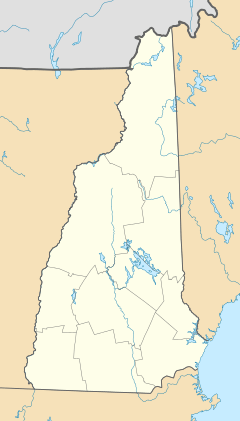Woodsville, New Hampshire facts for kids
Quick facts for kids
Woodsville, New Hampshire
|
|
|---|---|

Bird's-eye view in 1908
|
|
| Country | United States |
| State | New Hampshire |
| County | Grafton |
| Town | Haverhill |
| Area | |
| • Total | 1.88 sq mi (4.86 km2) |
| • Land | 1.85 sq mi (4.79 km2) |
| • Water | 0.03 sq mi (0.07 km2) |
| Elevation | 456 ft (139 m) |
| Population
(2020)
|
|
| • Total | 1,431 |
| • Density | 773.51/sq mi (298.68/km2) |
| Time zone | UTC-5 (Eastern (EST)) |
| • Summer (DST) | UTC-4 (EDT) |
| ZIP code |
03785
|
| Area code(s) | 603 |
| FIPS code | 33-87140 |
| GNIS feature ID | 0870998 |
Woodsville is a village in New Hampshire, United States. It is the largest village in the town of Haverhill. Woodsville is located in Grafton County, right next to the Connecticut River. The Ammonoosuc River also flows into the Connecticut River here.
In 2020, about 1,431 people lived in Woodsville. Even though North Haverhill is now the official county seat for Grafton County, Woodsville used to hold that title. The county courthouse was first built in Woodsville. Today, the county buildings are located between Woodsville and North Haverhill.
Contents
History of Woodsville
Woodsville got its name from John L. Woods. He was an important person in the early days of the village. In 1829, he bought a sawmill that had been working on the Ammonoosuc River since 1811. A sawmill is a factory where logs are cut into lumber.
John L. Woods made pine lumber and opened a store in his home. In the spring, when snow melted, it would carry logs down the Connecticut and Ammonoosuc rivers. A special barrier, called a log boom, was built across the Connecticut River. This boom held the logs so they could be sorted. Logs not needed for Woods' mill were slowly released to prevent traffic jams of logs further downstream.
Railroad Era
In 1853, the Boston, Concord & Montreal Railroad came to Woodsville. This brought a lot of growth to the village. The railroad built its main offices and a repair shop here. They also replaced an old bridge with a new one that had two levels. The lower level was for cars, and the upper level was for trains.
Woodsville quickly became an important railway town. It was a place where different train lines met. Many beautiful Victorian buildings were built during this time. The village also became a center for legal work.
The practice of floating logs down the rivers stopped after 1915. This was because people who owned pleasure boats complained that the logs were dangerous. In 1889, the Grafton County Court moved to Woodsville. It stayed there until 1972, when it moved to its current location between Woodsville and North Haverhill.
Geography of Woodsville
Woodsville covers a total area of about 1.88 square miles (4.86 square kilometers). Most of this area is land, about 1.85 square miles (4.79 square kilometers). A small part, about 0.03 square miles (0.07 square kilometers), is water.
The Ammonoosuc River flows through Woodsville. It joins the larger Connecticut River right in the village.
Transportation and Services
Several important roads cross through Woodsville. These include U.S. Route 302 and state routes 10 and 135.
Woodsville is a main shopping and service area for Haverhill and nearby towns. This includes some towns in Vermont just to the west. You can find supermarkets, restaurants, and banks near where US 302 and NH 10 meet. Cottage Hospital, which is an important hospital for the area, is also located in Woodsville.
Population of Woodsville
| Historical population | |||
|---|---|---|---|
| Census | Pop. | %± | |
| 1950 | 1,542 | — | |
| 1960 | 1,596 | 3.5% | |
| 1970 | 1,336 | −16.3% | |
| 1980 | 1,195 | −10.6% | |
| 1990 | 1,122 | −6.1% | |
| 2000 | 1,081 | −3.7% | |
| 2010 | 1,126 | 4.2% | |
| 2020 | 1,431 | 27.1% | |
| U.S. Decennial Census | |||
In 2010, there were 1,126 people living in Woodsville. There were 482 households, which means groups of people living together. About 293 of these were families.
Most of the people living in Woodsville were white (96.5%). A small number were Asian (1.5%), Native American (0.5%), or African American (0.2%). Some people were from two or more races (1.9%). About 1.2% of the population was Hispanic or Latino.
About 30.7% of households had children under 18 living with them. About 23.9% of all residents were under 18 years old. The average age of people in Woodsville was 38.0 years.
Notable people
- Ann Stone Minot (1894–1980), a professor and research scientist at Vanderbilt University.
- Chad Paronto, a baseball pitcher who played for teams like the Baltimore Orioles and Atlanta Braves.
- Bob Smith, a baseball pitcher who played for teams like the Boston Red Sox and Detroit Tigers.
- Mark Steyn, a well-known writer and columnist.
Images for kids
See also
 In Spanish: Woodsville (Nuevo Hampshire) para niños
In Spanish: Woodsville (Nuevo Hampshire) para niños








